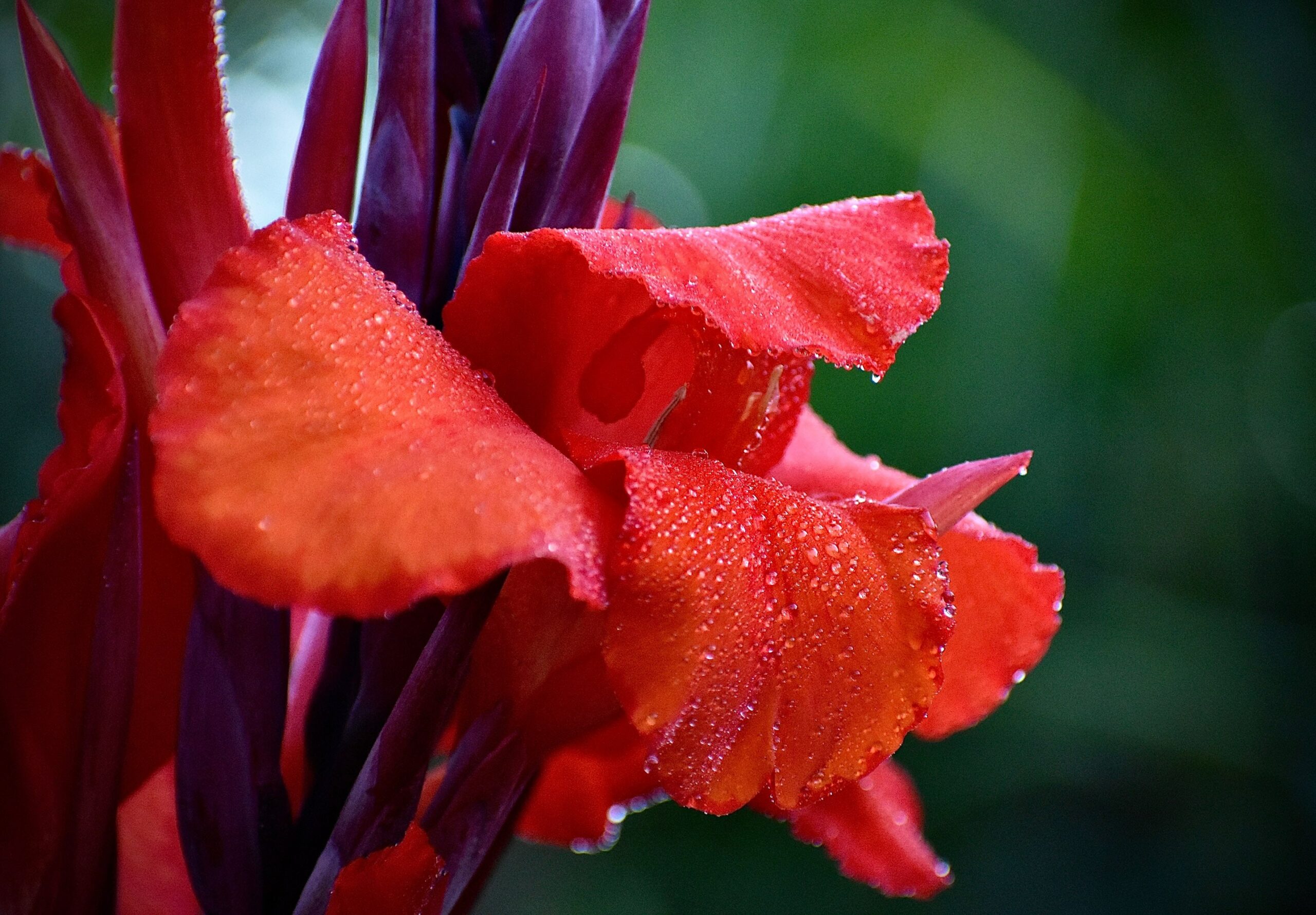Ah, the Canna Lily! A favorite of gardeners everywhere, this majestic flower is a showstopper in any landscape. From its vibrant colors and unique form, to its hardy nature and low maintenance needs—the Canna Lily is truly a gardener’s dream come true. But don’t be fooled by its easygoing attitude! Growing and caring for Canna Lilies can be quite tricky if you don’t know what you’re doing. So if you’re ready to get your hands dirty and learn the ins-and-outs of this beautiful bloom, keep reading!
This article will provide you with all the tips and tricks necessary for successfully growing, maintaining, and propagating Canna Lilies. We’ll cover everything from soil preparation to how to fertilize your plants in order to ensure optimal growth. You’ll also learn about common pests and diseases that may threaten your crop as well as how to combat them efficiently. Lastly, we’ll discuss propagation techniques that will help you build a bigger, better garden full of beautiful Canna Lilies!
By the end of this article, you’ll feel confident in your ability to cultivate these gorgeous flowers like a pro. So grab your garden gloves and get ready—it’s time to grow some breathtaking blooms!
Selecting A Canna Lily Variety
Choosing the right variety of Canna Lily is an important step in growing healthy plants. With so many different colors and sizes available, it can be hard to decide which one is best for your garden. Fortunately, there are a few tips and tricks you can use to make sure you get the perfect plant for your space.
First, consider the size of your garden or outdoor area where you plan to grow the Canna Lilies. If it’s a small space, stick with smaller varieties that won’t take up too much room. For bigger areas, go with larger varieties that will provide more impact and color. You should also think about the climate in your area and select a variety that will thrive in those conditions.
Finally, pick a color that enhances whatever other plants you already have growing in your garden. There are so many vibrant colors to choose from such as pink, red, yellow, orange and white—so make sure to pick something that stands out! With these helpful tips in mind, you’ll be ready to select the perfect Canna Lily for your garden. Now let’s move on to getting the soil prepared for planting!
Preparing The Soil For Planting
Planting canna lilies is like painting a masterpiece: it requires careful preparation to get the most out of your canvas. Preparing the soil for planting is an essential step in creating an outdoor oasis that blooms with canna lilies. Here are some key steps you should take: • Test your soil’s pH level and add amendments if necessary • Incorporate plenty of compost or manure into the soil to improve drainage • Add a balanced, slow-release fertilizer for long-term nutrition
When you’ve got the essentials, you can start preparing the area where you plan to plant your canna lilies. After you’ve determined the best spot, loosen up the soil by digging up at least 12 inches deep, removing any weeds or debris. If your soil is very compacted or has poor drainage, incorporate sand or horticultural grit to improve aeration and water flow. Once you’re done prepping and amending your soil, it’s time to get planting!
At this stage, it’s important to remember that even though they need lots of sunshine and warmth, canna lilies do best when planted in slightly moist but not soggy conditions. To ensure optimal growth and health of your plants, water them during dry spells and mulch around their base after planting. With these simple steps, you’ll be well on your way to growing lush and vibrant canna lilies in no time!
Planting Canna Lilies
When it comes to planting canna lilies, the best way to ensure success is to plan ahead. Take for example, Nancy who has a sunny flower bed in her backyard. She wants to spruce it up with some beautiful and colorful canna lilies. To do this, she needs to prepare the soil before planting.
First, Nancy should choose a spot that gets at least 6-8 hours of direct sunlight each day and make sure that the soil is well draining. She should also mix in compost or other organic material into the soil for added nutrients. Once these steps are complete, she can begin planting her canna lilies.
The best time of year to plant canna lilies is in late spring when the risk of frost is low. The bulbs should be planted about 2-3 feet apart and buried 4-6 inches deep in the ground with the pointed side facing up. After placing them in the soil, Nancy can cover them with mulch or other organic matter to help retain moisture and keep weeds away from her plants. Finally, she should water her newly planted bulbs generously but not overwater them as this can lead to root rot and fungal diseases.
Caring for newly planted cannas requires patience as they may take a few weeks to adjust before showing any signs of growth above ground. But with proper care and attention, Nancy will soon have a full bed of beautiful blooms that will last until fall!
Watering And Feeding Cannas
Watering and feeding cannas are essential for a healthy, successful garden. The key is to make sure the soil is moist without over-watering. When it’s hot outside, it may be necessary to water your cannas twice per day. You can also feed your cannas with a balanced fertilizer once or twice a month during the growing season.
When feeding your cannas, avoid fertilizers with too much nitrogen as this can cause leggy growth. A slow-release fertilizer is ideal and will help the plants grow strong and develop larger blooms. Additionally, you may want to use mulch around the plants to help retain moisture in the soil and reduce weeds.
No matter how well you take care of your cannas, weeds will inevitably pop up from time to time. It is important that you keep on top of weed removal so that your plants don’t suffer from competition for nutrients or sunlight. To control weeds around cannas, pull them out manually when they are small or use an organic herbicide such as corn gluten meal or vinegar spray when dealing with larger weeds. With proper watering and feeding practices coupled with regular weeding, you can ensure that your canna lilies remain healthy and beautiful throughout the season!
Controlling Weeds Around Cannas
Controlling weeds around cannas is an important part of caring for these beautiful flowers. The competition between the canna lily and the weeds can be intense, so it’s important to take measures to ensure the lilies get all the nutrients they need. Here are a few ways to keep your canna lilies healthy and weed-free:
• Pulling Weeds by Hand: This is a great way to start, as it gets rid of any existing weeds without introducing chemicals into your garden. It also allows you to handpick any plants that may be encroaching on your lilies’ space. • Mulching: Applying mulch not only helps retain moisture but also helps control weeds by blocking out light from reaching them. This prevents germination and can help stifle growth in existing ones. • Herbicides: If manual methods aren’t enough, you can use herbicides specifically designed for controlling weeds around cannas; however, this should be done with caution as some herbicides may damage or kill the plants if used incorrectly or in excess.
Keeping up with regular maintenance will help reduce the spread of weeds, but in some cases, manual removal may still be necessary. Don’t forget to check your plants regularly for signs of infestation and take appropriate action when needed. With consistent care and attention, you’ll have beautiful blooms all season long!
Now that we’ve discussed how to control weeds around cannas, let’s talk about pruning them for optimal growth and health.
Pruning Cannas
Pruning cannas is like sculpting a beautiful piece of art. It requires creativity, dedication, and patience. The goal of pruning cannas is to maintain their shape and size while ensuring healthy growth in the future.
When pruning canna lilies, it’s important to be strategic about which parts of the plant are cut away. Start by removing any dead or damaged foliage from the base of the plant and trimming off flower stems that have already bloomed. This will help promote more blooms for next season. If you wish to reduce the size of your canna lily plants, you can also safely prune away up to one-third of their height.
It’s best to wait until the middle of summer or early fall before pruning cannas so that they have time to establish new roots and grow back vigorously before winter arrives. When done correctly, regular pruning can help keep your canna lilies looking their best year after year!
With proper pruning in place, it’s time to focus on protecting cannas from pests and diseases that may damage their foliage or cause them to stop flowering altogether.
Protecting Cannas From Pests And Diseases
Pests and diseases can be a major issue when growing cannas. While they aren’t especially prone to them, if left unchecked they can quickly take over and cause damage to your beautiful lily. Fortunately, there are a few steps you can take to protect your plants from these issues.
For starters, it’s important to make sure the soil is well-drained and that the plant gets plenty of sunlight for at least six hours per day. This will help keep the environment around the plant healthy and decrease its risk of developing an infection or infestation. Additionally, it’s also a good idea to check your canna lilies regularly for signs of pest or disease problems such as yellowing leaves or wilting stems. If you notice any of these issues, act quickly by removing any affected parts and treating the plant with an appropriate pesticide or fungicide as needed.
Finally, another important thing you can do is practice proper sanitation when caring for your plants. Always dispose of old foliage or mulch in sealed bags away from other plants; this will help prevent pests and diseases from spreading further. Additionally, be sure to always use clean gardening tools when working in your garden – this will help reduce the risk of introducing bacteria or viruses into your canna lilies’ soil.
By following these tips, you’ll be able to keep your plants strong and healthy so that they can enjoy many years of blooming beauty without worry! Now let’s look at how we can dig up, divide, and replant our cannas for even more vibrant growth in the future!
Digging, Dividing And Replanting Cannas
Digging, dividing and replanting cannas is a great way to keep your garden looking fresh. This process helps to ensure the health of existing plants and can help to propagate new ones. It’s an easy way to care for your canna lilies and add variety and color to your garden.
When it comes time to dig, remember that timing is everything. Cannas should be divided in early spring or fall, as this is when they are most likely to thrive. Be sure to use a sharp spade or shovel when digging up the roots, as this will minimize damage. Also take care not to disturb the rhizomes too much, as they are delicate and can easily become damaged during division.
Once you have divided the canna lilies, it’s time for planting! When picking out a spot for planting, look for an area with plenty of sun exposure and good drainage. Make sure you plant each division at least one foot apart from each other so they have enough space to grow. Then cover them with soil and lightly water them in order to help them get established in their new home.
By following these simple steps for digging, dividing and replanting cannas, you’ll be on your way towards propagating beautiful plants that will make your garden even more vibrant!
Propagating Cannas
Propagating cannas is a great way to increase the number of plants you have without having to buy more. You can easily propagate them from seed, or you can divide existing plants and replant them in new areas. This process is simple and can be done at any time of year.
When propagating cannas from seed, make sure to choose a variety suited for your climate and soil type. Plant the seeds about two inches deep in moist potting soil, and keep them consistently watered until germination occurs. When the seedlings are around three inches tall, you can move them into their permanent spot outdoors or in containers.
Division is another method of propagating cannas which works especially well with mature plants that have reached a desirable size. To do this, dig up an entire clump of rhizomes (the roots) with a shovel and then separate it into smaller sections with sharp shears or a knife. Make sure each section has some leaves attached as well as healthy roots before replanting it in its new home.
Now that you know how to propagate cannas from both seed and division, you’re ready to prepare for winter by learning how to properly overwinter your plants.
Overwintering Cannas
Cannas are like a surprise package of joy, bursting with beauty and life in the garden. Overwintering cannas properly is the key to ensuring you will have the same pleasure next year. With a few simple steps, you can keep your canna lilies healthy for many years of enjoyment.
First, it is important to cut back canna foliage after flowering has stopped and all danger of frost has passed. This will ensure that no new growth is damaged by cold weather or disease. Then, it’s time to dig up the rhizomes at least 6 inches deep in order to preserve them from freezing temperatures. Once they’ve been dug up, brush off any excess soil and then let them dry in a warm area for a few days before storing them in peat moss or vermiculite until springtime when they can be replanted.
Finally, one of the simplest ways to get your cannas through winter safely is by covering them with several inches of mulch or straw. Doing this will protect the rhizomes from extreme temperatures and help keep moisture levels consistent throughout the season. Just remember not to disturb your cannas while they overwinter so that they can come back bigger and better than ever! With these easy tips, you’ll be able to enjoy your beautiful canna lilies for many years to come!
Growing Cannas In Containers
Did you know that over 15 million cannas are sold each year? That is a lot of beautiful blooms and foliage! Growing cannas in containers is a great way to enjoy them, as long as you follow some basic guidelines.
When it comes to growing cannas in containers, the size of the container matters. For best results, your container should be at least 12 inches deep with plenty of room for the plant’s roots. You’ll also need to use a well-draining potting soil, and make sure the container has adequate drainage holes. It’s also important to find a spot that gets plenty of bright light but not too much direct sunlight, since too much sun can damage the leaves.
In addition to choosing the right pot and soil for your canna lily, you’ll need to water it regularly and fertilize it on occasion. Watering should be done when the top layer of soil feels dry and fertilizer should be applied every two or three weeks while the plant is actively growing. When winter arrives, you’ll need to move your canna lily indoors if you want it to survive until spring.
By following these tips for container gardening, you can enjoy vibrant canna lilies all season long! Now let’s explore how to grow them as houseplants so that they can stay with you no matter what time of year it is.
Growing Cannas As Houseplants
Cannas are beautiful and versatile plants that can add a unique tropical flair to any home. Whether you grow them outdoors as bedding plants or indoors as houseplants, you can enjoy the lush foliage and colorful blooms of cannas year-round. Here’s how to get started with growing cannas as houseplants:
First, choose a container that is deep enough for the roots and drainage holes on the bottom. Next, fill the container with a quality potting soil that drains well. Lastly, place your canna in an area of your home with bright indirect light.
Take care to keep the soil evenly moist but not soggy, and make sure to fertilize twice a month during its active growing season. With proper care, your canna will thrive indoors and bring you joy all year long!
In addition to providing beauty and color inside your home, one of the advantages of growing cannas indoors is the opportunity for companion planting. By combining different types of houseplants in one container, you can create a stunning display while also benefiting each plant’s growth and health.
Companion Planting With Cannas
Like a beautiful tapestry, companion planting with cannas can bring extra color and texture to the garden. From adding nitrogen in the soil to deterring pests, the right combinations of plants can be a great boon for your canna lily. Let’s explore how these two worlds come together.
To start, it’s important to understand which plants are compatible with cannas. Companion plants should have similar needs such as sunlight and pH levels so they can thrive alongside your canna lilies. Many annuals and perennials work well as companions for cannas, including salvia, cosmos, marigolds, and rudbeckia.
In addition to providing visual interest in the garden, companion planting also helps protect your cannas from disease and pests. For example, marigolds are known to be natural insect repellents that discourage harmful bugs from eating away at your lilies. Planting these flowers near your cannas will help ward off potential invaders without having to use chemical treatments or pesticides.
When it comes to growing healthy cannas in your garden, companion plants are powerful allies that offer both beauty and protection. With thoughtful planning and proper care, you can create an impressive display that will last all season long!
Tips For Successful Growing Of Cannas
When it comes to adding a colorful, vibrant touch to your garden, the canna lily is an ideal choice! With its delicate petals and lush foliage, it can transform any outdoor space into a paradise. But in order to ensure that your cannas reach their full potential, there are certain tips you must follow.
First off, it’s important to remember that cannas need plenty of sunlight and warmth in order to thrive. Choose a spot where these conditions are met and provide some protection from strong winds. For best results, make sure you water them regularly and feed them with a balanced fertilizer every few weeks.
It’s also essential to properly prepare the soil before planting. Make sure it’s rich in organic matter and drains well so that your cannas don’t suffer from root rot or other moisture-related issues. Finally, be sure to mulch around the base of each plant for additional insulation during cold weather and improved weed control.
By following these simple steps you’ll be on your way to growing stunning canna lilies that will bring beauty and life into your garden! Now let’s move on to troubleshooting common canna problems so that you can enjoy their blooms for seasons to come.
Troubleshooting Common Canna Problems
Cannas are a stunningly beautiful flower, capable of bringing an entire garden to life! Troubleshooting common canna problems can be a daunting task—especially for novice gardeners. But with the right know-how, it’s easier than you think. Here are some tips and tricks to help you get the most out of your canna lily:
- Investigate the roots: Roots that are too wet or too dry could lead to stunted growth or even death in your canna lily. Inspect the roots regularly and make sure they’re receiving enough water but not becoming waterlogged.
- Be mindful of pests: Pests like aphids, mites, and slugs love to feast on canna lilies! Make sure to keep an eye out for any signs of infestation and take steps quickly if needed.
- Pay attention to sunlight exposure: Cannas need at least six hours of direct sunlight every day in order to thrive—so make sure to pick a spot in your garden that gets plenty of sunshine throughout the day!
With these tips in mind, you’ll be well on your way towards successfully growing and caring for your own stunning canna lily! From inspecting roots to keeping an eye out for pests, there’s lots that goes into delivering your lovely blooms year after year. So don’t forget: with a little bit of tender loving care and some patience, you’ll have beautiful cannas in no time at all!
Frequently Asked Questions
What Is The Best Climate For Growing Cannas?
When it comes to growing cannas, climate plays an important role. Coincidentally, cannas are native to tropical and subtropical regions and thrive in temperate climates with plenty of sun and heat. They do best in areas where the temperature doesn’t drop below 40 degrees Fahrenheit or 4 degrees Celsius.
So if you’re looking to grow these flowers in your garden, consider a location that has warm summers, plenty of sunshine and bright colors, and good drainage. You should also ensure that the soil is well-draining yet moist so that it can provide adequate nutrition for the plants. Additionally, you may want to add a layer of mulch around the base of the plants to help keep moisture levels consistent throughout the season.
When it comes to caring for your cannas, make sure you water them regularly but avoid overwatering so that their roots don’t become saturated and rot. Also, keep an eye out for pests such as aphids or caterpillars, which can be controlled with a light spray of insecticidal soap or neem oil solution. Lastly, you should fertilize your cannas once every few weeks during the growing season using a balanced fertilizer like 10-10-10.
TIP: If temperatures in your region fall below 40 degrees Fahrenheit or 4 degrees Celsius during winter months, consider planting your cannas in containers that can be brought indoors during colder weather to protect them from frost damage.
How Often Do I Need To Water And Feed Cannas?
Watering and feeding cannas can seem like a daunting task, but with proper care, these beautiful flowers can reward you with blooms for months. To take the best care of your cannas, you’ll need to know how often they should be watered and fed.
When it comes to watering, cannas prefer soil that is kept consistently moist. However, they don’t like to sit in waterlogged soil. The best way to ensure that the plants are properly hydrated is to water them deeply once or twice a week—more often if there are extreme temperatures or low humidity levels.
In terms of feeding, canna lilies should be fertilized every two weeks during their growing season. Choose a balanced fertilizer such as 10-10-10 or 5-10-5 and apply according to package instructions. It’s also important to make sure that the soil pH level remains between 6.0 and 7.0 for optimal growth.
Taking the time to properly water and feed your cannas will help ensure that they thrive all season long! With regular attention and some TLC, these showy flowers will reward you with beautiful blooms for months on end.
How Do I Know When To Divide And Replant Cannas?
Cannas are an eye-catching addition to any garden, and it’s easy to see why – they come in a variety of sizes and colors, with some varieties reaching up to 8 feet tall! It’s important to know when to divide and replant them so you can keep your garden looking its best.
The first step is understanding the life cycle of cannas. They typically bloom for around six months, after which their foliage will start to die back. At this point, you should divide the rhizomes – the underground stems that store energy for the plants – into clusters of three or four. This will help encourage new growth and further flowering.
It’s also important to remember that cannas prefer warm temperatures and plenty of moisture. So if your region gets cold in winter, then you may want to consider planting them in containers that can be brought indoors during colder months. Additionally, make sure that the soil is well-draining and fertilize them regularly with a balanced fertilizer, such as 10-10-10 or 20-20-20, for optimal results.
Taking proper care of your cannas can ensure they look their best year after year! With just a few simple steps you can easily keep your garden looking vibrant and colorful all season long.
Is It Possible To Grow Cannas Indoors?
Growing cannas, with their lush foliage and colorful blooms, is a popular way to brighten up any outdoor space. According to the American Canna Society, more than 350 species of this type of lily exist across the world. But can it be done indoors?
The answer is yes! While it’s more difficult to grow cannas inside, with the right conditions and some dedication, it can be done. They need plenty of indirect sunlight, as well as temperatures that don’t drop below 55 degrees Fahrenheit. You’ll also need to water them frequently and keep the soil evenly moist but not soggy.
One key thing to note when growing cannas indoors is that they won’t flower like they do outdoors in ideal weather conditions. However, if you’re willing to put in the effort and provide your cannas with all the necessary care, you can enjoy their beautiful foliage for years to come. So why not give it a try?
Are There Any Companion Plants I Should Avoid Planting With Cannas?
Research shows that over one million species of plants are grown in gardens around the world.1 This includes the popular canna lily, which is suitable for a variety of climates and soils. When planning a garden with cannas, however, it’s important to consider companion plants and avoid planting certain species together.
Cannas need well-drained soil and plenty of sunlight, so it’s best to choose companion plants that will thrive in similar conditions. Certain varieties of grasses work well with cannas as they help retain moisture in the soil and don’t compete for nutrients. For contrast, you could also try adding some annuals to your garden such as petunias or marigolds.
On the other hand, there are some plants you should avoid when growing cannas. These include tomatoes and potatoes as they tend to draw away vital nutrients from the soil that cannas need to grow healthy and strong. It’s also worth noting that some herbs like rosemary can stunt the growth of your canna lilies if planted too close together.
When selecting companion plants for your canna lilies, it’s essential to consider their growing requirements and make sure they don’t interfere with each other’s development. With careful planning, you can create a beautiful outdoor space featuring vibrant canna lilies surrounded by complimentary flora.
Conclusion
Conclusion: Cannas are a colorful and vibrant addition to any garden, and with proper care, they can bring life and beauty to any outdoor space. With the right climate, regular watering and feeding, dividing and replanting when necessary, and avoiding certain companion plants, home gardeners can successfully grow cannas in their own gardens. Growing cannas indoors is also possible with the right amount of light and temperature control. By providing the proper conditions for growth and following these simple steps for caring for cannas, anyone can create a captivating landscape perfect for summertime relaxation.
Overall, growing cannas is an exciting experience that rewards gardeners with stunning colors and textures. From their bright blossoms to their lush foliage, cannas are an excellent choice for adding interest to any outdoor space. With the proper care and attention, your backyard can become a paradise of colorfully flourishing flowers ready to be admired. So don’t hesitate – grab your gardening gloves and get ready to relish in the rewarding experience of cultivating a thriving canna lily garden!





























